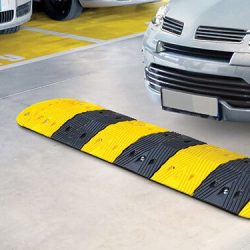Speed humps are raised sections of road designed to reduce vehicle speed, similar to speed bumps but with a gentler slope. They are typically longer than speed bumps, extending 12 to 14 feet across the roadway, which slows vehicles to a safe speed without causing discomfort. Speed humps are ideal for residential streets, where maintaining a moderate speed limit is important for the safety of pedestrians, cyclists, and drivers alike.
How Speed Humps Contribute to Safer Neighborhoods
When it comes to maintaining safety in residential areas, speed humps are one of the most effective tools available. But what makes them so beneficial for neighborhood traffic control? Let’s delve into the advantages of speed humps and how they help create safer, quieter communities.The Benefits of Speed Humps
1. Effective Speed Control: Speed humps are highly effective in reducing vehicle speeds to safer levels in residential areas. Their design encourages drivers to slow down without coming to a complete stop, making them ideal for maintaining a steady flow of traffic. 2. Enhanced Pedestrian Safety: In neighborhoods where children play and residents walk or bike, speed humps help protect pedestrians by ensuring that vehicles travel at safer speeds. This reduces the risk of accidents and improves the overall safety of the community. 3. Traffic Flow Management: Unlike speed bumps, which are more abrupt, speed humps allow for smoother traffic flow while still enforcing speed limits. This makes them suitable for longer stretches of residential streets where maintaining a consistent speed is important. 4. Noise Reduction: Because speed humps encourage gradual slowing rather than abrupt stopping, they contribute to lower noise levels compared to speed bumps. This is particularly beneficial in residential areas where noise pollution is a concern. 5. Long-Term Durability: Speed humps are made from durable materials like asphalt or concrete, designed to withstand heavy traffic and last for many years. Their longevity ensures ongoing safety benefits without frequent replacements. 6. Cost-Effective Traffic Calming: Installing speed humps is a cost-effective way to enhance safety in residential areas. They require minimal maintenance and provide long-term benefits, making them a smart investment for municipalities and homeowners’ associations.How to Choose the Right Speed Humps
When selecting speed humps for a residential area, consider the following:- Material: Asphalt and concrete are the most common materials used for speed humps, offering durability and stability. Rubber speed humps are also available for temporary or less permanent installations.
- Height and Length: Speed humps are typically 3 to 4 inches high and 12 to 14 feet long. This design slows vehicles to 15-20 mph, which is ideal for residential streets.
- Visibility: Ensure the speed humps are marked with reflective paint or signs to alert drivers of their presence, especially at night.
- Placement: Speed humps should be placed strategically on long, straight roads where speeding is common, and near areas where pedestrian activity is high.

